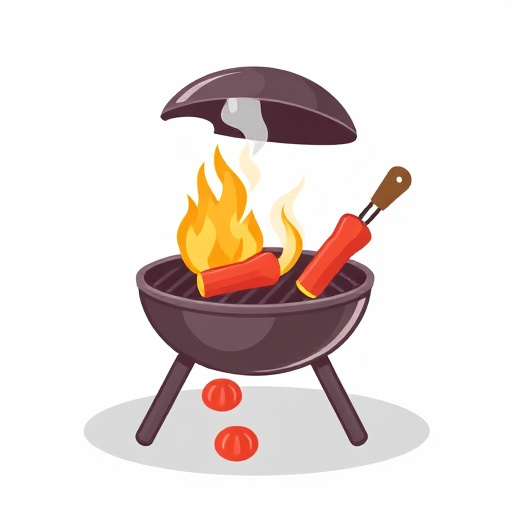Baking a perfect BBQ Brisket Recipe Oven involves careful preparation and specific techniques. Key steps include separating flat and point muscles, managing fat cap, using a low-and-slow cooking method, selecting the right cut with ample marbling, creating a flavorful rub, maintaining precise temperatures (250°F – 300°F), utilizing drip pans and foil wrapping for moisture retention, and serving with complementary sides. This approach ensures a juicy, tender brisket accessible to BBQ beginners while satisfying experienced cooks.
Looking to master the art of oven-baked brisket? This ultimate guide is your perfect starting point for crafting a mouthwatering BBQ brisket recipe without the usual hassle. We demystify the cut, from understanding its structure to selecting the best quality meat. Learn why slow-roasted brisket is a beginner’s dream and discover essential tools to achieve tender, flavorful results. From seasoning techniques to moisture retention tricks, we’ve got you covered for every step of the process. Get ready to impress with your homemade oven-baked brisket masterpiece!
- Understanding Brisket: The Cut and Its Significance
- Why Oven-Baked Brisket is Ideal for Beginners
- Essential Tools and Equipment for the Perfect BBQ Brisket Recipe
- Choosing the Right Brisket: Quality and Preparation
- Seasoning 101: Creating a Basic Rub for Flavorful Results
- The Science Behind Slow Cooking: Temperatures and Times
- Techniques for Moisture Retention and Tenderization
- Serving Suggestions and Side Dishes to Compliment Your Oven-Baked Brisket
Understanding Brisket: The Cut and Its Significance
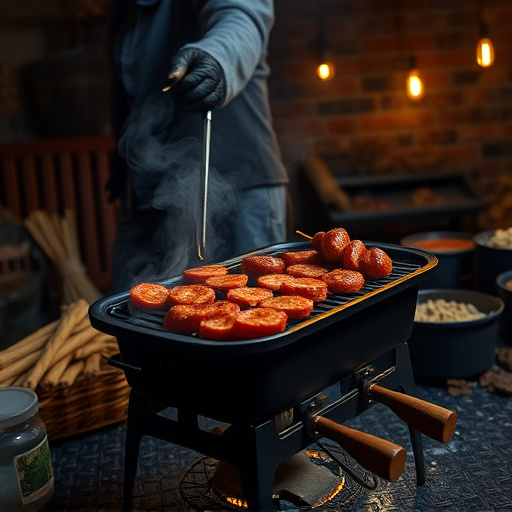
Brisket, a cut from the beef chest, is a favorite among BBQ enthusiasts for its rich, succulent flavor and tender texture when cooked properly. When preparing brisket in an oven, understanding this particular cut becomes even more crucial. The brisket is composed of two muscles: the leaner, more flavorful flat muscle and the fattier, marbled point. For an optimal BBQ brisket recipe oven-baked, it’s essential to separate these muscles at the natural seam, ensuring even cooking and maximum juiciness.
The fat cap on the point acts as a natural wrapper, keeping the meat moist during slow-cooking in the oven. This is why many beginner-friendly BBQ brisket recipes involve starting with a low-and-slow method, allowing the fat to render and the flavors to meld together. Properly managing this cut will result in a mouthwatering, tender brisket that lives up to its reputation as one of the most satisfying dishes in the BBQ world.
Why Oven-Baked Brisket is Ideal for Beginners
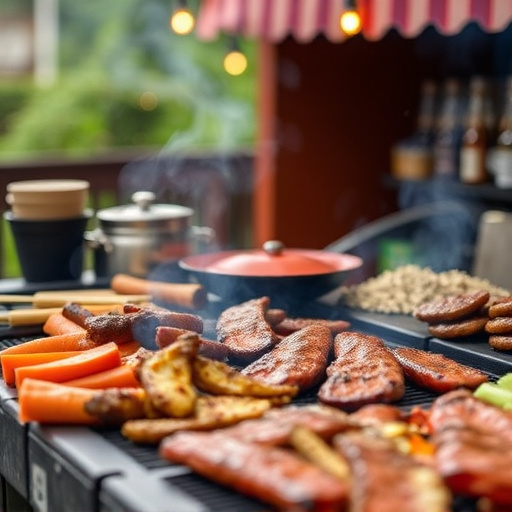
Oven-baked brisket is an excellent choice for BBQ beginners due to its ease of preparation and consistent results. Unlike traditional smoking methods, baking allows for a more hands-off approach, making it less intimidating for newcomers to this culinary art. With just a few simple steps and basic kitchen tools, you can create a mouthwatering BBQ brisket recipe without the hassle of setting up and maintaining a smoker.
Moreover, oven-baked brisket ensures a tender and juicy end product. The slow-roasting process allows the meat to break down, resulting in a tender texture that slices easily. This method also helps maintain moisture, preventing the brisket from drying out, which is a common concern for first-time BBQ enthusiasts. Whether you’re aiming to impress your family or friends, oven-baked brisket offers a straightforward and delicious entry point into the world of BBQ.
Essential Tools and Equipment for the Perfect BBQ Brisket Recipe

To achieve the perfect BBQ brisket recipe using an oven, several essential tools and equipment are indispensable. Firstly, invest in a high-quality oven thermometer to ensure precise temperature control throughout the slow-cooking process. This is crucial for maintaining the ideal environment that allows the brisket to become tender and flavorful. Additionally, a reliable oven-safe meat thermometer is vital; it helps you monitor the internal temperature of the brisket, ensuring it reaches the recommended level for safety and maximum juiciness.
Another key piece of equipment is a large, heavy-duty roasting pan or a Dutch oven. These containers are designed to retain heat efficiently, which is essential for slow-roasting methods. A good-quality meat tenderizer or a fork with sturdy tines can also come in handy for breaking down the brisket’s tough muscle fibers during and after cooking. Lastly, don’t underestimate the power of aluminum foil; it’s perfect for wrapping the brisket tightly to lock in moisture as it cooks in the oven, resulting in a delectable, tender BBQ brisket recipe.
Choosing the Right Brisket: Quality and Preparation
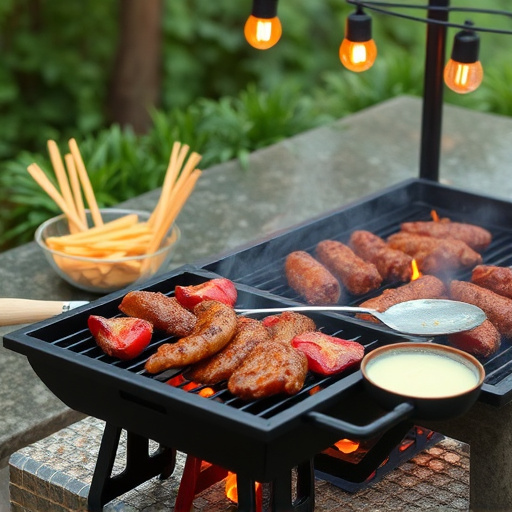
When it comes to crafting the perfect oven-baked brisket, selecting the right cut is paramount. Opt for a high-quality, well-marbled beef brisket to ensure juicy, tender results. Look for meat that has good fat content; this natural moisture will keep your brisket delicious and prevent it from drying out during the slow cooking process. Proper preparation is also key. Brisket is a tough cut of meat that benefits immensely from long, slow cooking at low temperatures. Before baking, trim excess fat to reduce the cooking time and ensure even heat distribution. Seasoning is another vital step; a simple rub of salt, pepper, garlic, and paprika will infuse your brisket with flavor, but feel free to experiment with BBQ spices for an extra kick.
Choosing the right brisket and preparing it correctly sets the stage for a mouthwatering BBQ treat. Remember, patience is key when it comes to baking brisket; allowing it to cook slowly in the oven enables those delicious flavors to meld together, resulting in a tender, juicy masterpiece that will impress your family and friends.
Seasoning 101: Creating a Basic Rub for Flavorful Results
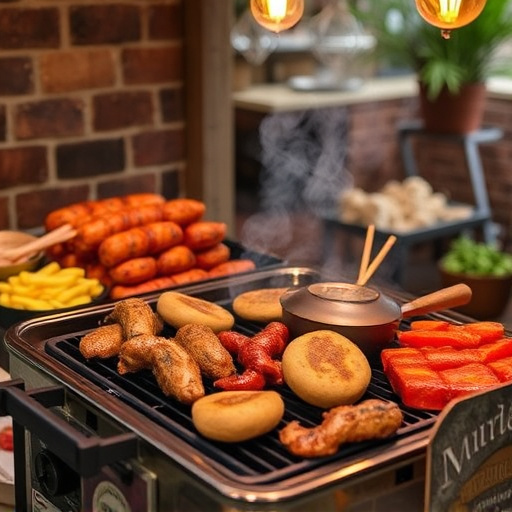
Creating a basic rub is the secret sauce for flavoring your oven-baked brisket, especially if you’re new to BBQ. Seasoning isn’t just about salt and pepper; it involves a delicate balance of spices that enhance the natural juices and fats in the meat. For beginners, start with a simple blend of coarse salt, black pepper, garlic powder, onion powder, paprika, cayenne pepper (for heat), and brown sugar. This combination adds depth and warmth to your brisket, creating a delicious crust without overpowering the meat’s inherent taste.
To use this rub effectively, evenly coat both sides of the brisket before cooking in the oven. You can do this up to an hour before baking for a basic approach or even marinate it overnight for extra flavor infusion. Remember, consistency is key; ensure every part of the meat is coated for optimal results with your BBQ brisket recipe oven-baked masterpiece.
The Science Behind Slow Cooking: Temperatures and Times
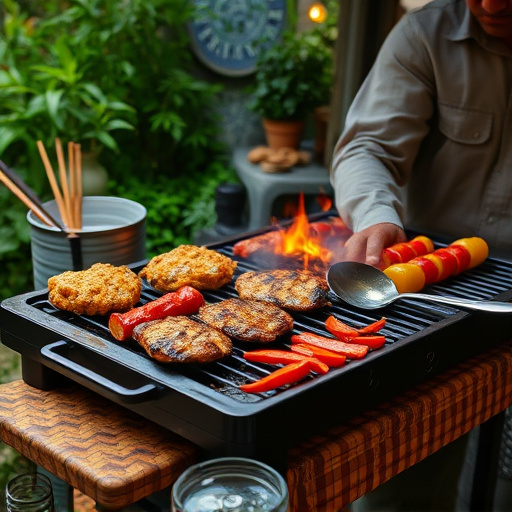
The art of slow-cooking brisket in an oven is a science as much as it is an art form, and understanding the temperatures and times involved is key to achieving delicious, tender BBQ brisket. Brisket is a cut of meat known for its tough connective tissues and fat, which can make it challenging to cook to perfection. The magic happens when time and low heat work in harmony to break down these tissues, resulting in a melt-in-your-mouth texture.
For an oven-baked brisket recipe, temperatures typically range between 250°F (120°C) and 300°F (150°C). Cooking at lower temperatures allows the heat to gently permeate the meat, slowly transforming it from tough to tender. A standard 10-pound (4.5 kg) brisket might take anywhere from 8 to 12 hours to cook, depending on the oven and desired doneness. The longer cooking time ensures that the collagen in the meat breaks down, creating a juicy, flavorful BBQ brisket recipe that will impress beginners and seasoned cooks alike.
Techniques for Moisture Retention and Tenderization
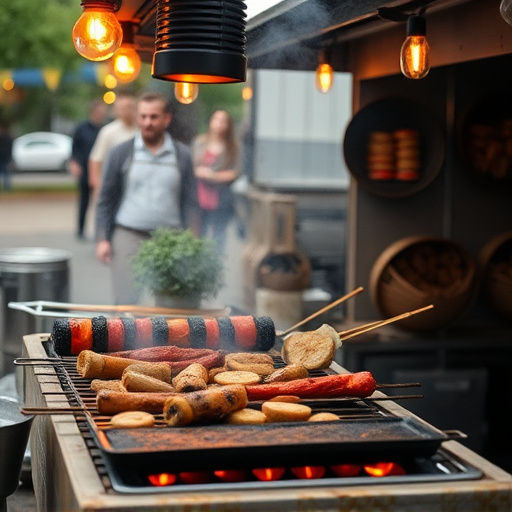
Baking a perfect brisket in the oven is an art, and moisture retention is key to achieving that mouthwatering, tender result. One effective technique for BBQ brisket recipe oven-style is to use a drip pan beneath the meat. This simple step allows the fat from the brisket to melt and slowly return moisture to the meat as it cooks, preventing dryness. Many novice cooks also wrap their brisket in foil after the initial searing stage, creating a steamy environment that tenderizes the tough cut of meat. This process, known as the “baste and wrap” method, ensures the brisket stays juicy and flavorful throughout the slow-cooking process.
Additionally, using dry rub or injecting the brisket with a brine solution before baking can significantly enhance its texture. Dry rubs, with their blend of spices, penetrate the meat’s surface, adding flavor as they help break down collagen, a protein in meat that contributes to toughness. Brining, on the other hand, involves soaking the meat in a salt and sugar solution, which also tenderizes and adds moisture, ensuring your oven-baked BBQ brisket turns out tender, juicy, and full of delicious smokey flavor.
Serving Suggestions and Side Dishes to Compliment Your Oven-Baked Brisket
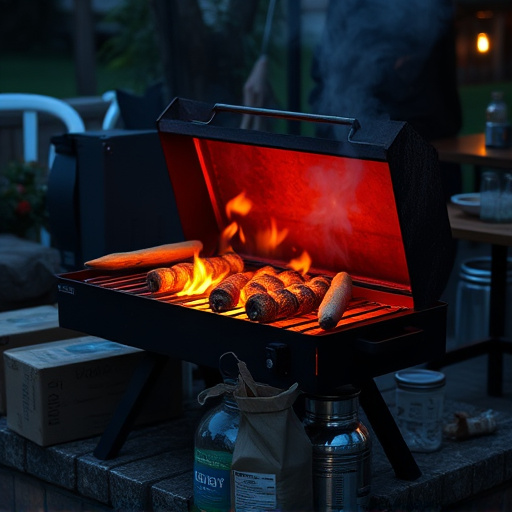
When it comes to serving your delicious oven-baked brisket, let’s explore some ideas to make it a memorable dining experience. A classic BBQ brisket recipe is never complete without hearty sides that complement its rich flavor. Consider offering a selection of fresh salads like coleslaw or potato salad to balance the richness of the meat. Additionally, baked beans, cornbread, and garlic mashed potatoes are fan-favorites that pair wonderfully with brisket. These sides not only enhance the overall taste but also provide a well-rounded meal for your guests.
For an extra touch, think about adding some charred vegetables or grilled corn on the cob as side dishes. These can bring a nice contrast in texture and flavor. Don’t forget to offer a variety of sauces—from classic BBQ sauce to a tangy mustard glaze—allowing each guest to customize their brisket experience. Serving suggestions like these will ensure your oven-baked brisket is not only mouthwatering but also a delightful spread that satisfies everyone.
